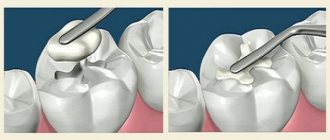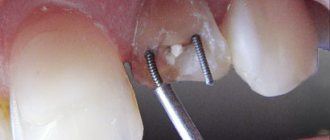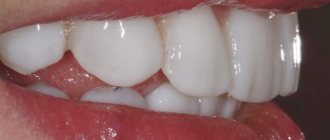Today, one of the pressing problems of modern dentistry remains the treatment of caries and its complications. At the same time, modern requirements for dental restoration are such that treatment should be minimally traumatic with a maximum service life of the restorations.
However, the problem of choosing structures, be it a simple restoration, an inlay or a crown, always remains a stumbling block and causes controversy among specialists from different countries. This publication, of course, will not resolve these disagreements. The purpose of the article is to demonstrate the benefits of treating cases of complicated caries using modern dental materials.
The greatest practical significance are those methods of treating patients that, at a minimum, do not reduce the average service life of the restoration, but reduce the cost for the patient and the time spent in the chair.
At the same time, the time spent on all visits to treat similar nosologies is equally expensive for both the patient and the doctor. Saving time for the patient reduces his stress and fatigue from treatment, which increases his motivation to “get treated quickly” and reduces the risk of the patient leaving the clinic due to long-term treatment.
Saving time for the doctor reduces fatigue and increases the turnover of funds and fixed assets of the clinic, i.e. the doctor can accept a new patient in the time freed up from multi-stage treatment and receive additional income, which at the end of the year can amount to plus several tens, or even hundreds of thousands rubles The main question remains: how to do this without losing quality.
Content
- Dental restoration methods
- Dental restoration with pins
- Dental restoration with inlays
- Dental restoration with crowns
The success of endodontic treatment largely depends on the subsequent restoration of the upper part of the tooth. It is the correct restoration of the crown after filling that is the key to a long-term, high-quality result without the risk of re-infection. Canal treatment is not considered complete until the doctor can guarantee that there is no risk of re-contamination.
Carrying out treatment
All manipulations are performed under local anesthesia. The tooth to be treated is prepared, the pulp affected by caries is removed, after which the canals are cleaned to ensure easy access for dental instruments.
The root canals are mechanically processed and chemically disinfected.
For mechanical treatment of root canals, special tools are used - files; they are somewhat similar to a needle with a rough surface resembling a saw. Files vary in size, length and taper. Since the root canal must be processed along its entire length with files, up to the apical foramen (but in no case beyond it), it is extremely important to find out its length. To do this, the dentist places files into the root canals and takes an x-ray.
After this, chemical disinfection is carried out by irrigating the root canals with special needles.
When the canals are completely dry, you can begin filling them. Gutta-percha and pastes are most often used for this purpose. Gutta-percha is a cone-shaped rubber rod that is coated with a paste and placed into the root canal. Then a temporary filling is placed on the tooth, which is replaced with a permanent one at the next appointment.
| Tooth destroyed by caries, inflamed pulp | Mechanical treatment of root canals with a file tool | Filling canals with gutta-percha, filling a tooth with a temporary and then permanent filling | For further protection, the tooth can be covered with a porcelain crown. |
Methods of dental restoration after endodontic treatment
Severely damaged teeth must be strengthened with additional means. This will help avoid fracture of the tooth stump and maintain its strength for a long time. Intra-canal pins and stump inlays are used as support. The choice of support element depends on how badly the tooth is damaged and what method will be used to restore it. Installation of an intracanal pin is advisable if there are only two walls of the crown, the height of which should not be less than three millimeters.
Unsealing of root canals and their treatment
Today it is no secret to anyone that the primary treatment of complicated caries, as well as orthograde revision of the root canal system, should be carried out using a rubber dam. With this type of isolation of the surgical field, it is possible to successfully carry out excavation of caries, opening of the tooth cavity, mechanical and medicinal treatment of the root canal system.
The Start-X™ ultrasonic tip system is very suitable for opening canal orifices and searching for additional canals.
For primary navigation and widening of narrow canals, today's flexible and durable nickel-titanium continuous rotation PathFile™ files are indispensable.
This very convenient range of instruments, consisting of 3 files, reduces the risk of fracture of the main file when expanding the root canal system, especially in severely curved sections. Next, if everything went well and the doctor confidently treated the root canals, he will have to obturate them. This can be done using both the good old method of lateral condensation of gutta-percha, and vertical condensation using various devices for heating gutta-percha and its condensation. For example, using the Calamus® Dual system for vertical condensation or the new Gutta Core™ obturator, which solves the problem of a plastic carrier that made it difficult to unfill the root canal in the long term. So, we have everything for root canal obturation, essentially, in one visit.
We have gone through and expanded the canal system well, treated it with sodium hypochlorite solution, etc., and if there are no direct indications for temporary medicinal investment and we have done everything according to the protocol recommended by the manufacturer of instruments for processing the canal system, we can dry the root canal well (no exudation and bleeding), nothing prevents us from obstructing it immediately.
We don't need another visit, for which both the patient and the doctor still need to find time. Time for coffee, time to prepare the office and chair, put on an apron, ask about the patient’s well-being, listen to the answer... say goodbye. All this can be avoided (and accepted at the next visit of a new patient) if you follow the recommended parameters of treatment and work with materials and instruments.
Selection of sealer
We just need to add to the above a neutral polymer sealer for obturation, which will allow you to enjoy all the benefits of adhesive dentistry in the same visit. As we know, oil-based sealers, for example, do not provide such an opportunity. Particularly convenient in the automatic mixing system, AH Plus® Jet™ polymer sealer is ideal for our one-visit treatment concept. And in combination with the AH Plus® cleaner system, a special composition of alcohols, it will not only obturate, but also clean the walls of the tooth cavity from sealer and prepare them for standard adhesive technology immediately after filling. If everything is so simple, why do we need to wait until the next day to finally restore the tooth?
You should probably wait for the final polymerization of the sealer. What happens to the sealer during polymerization? If we accept the statement that hot gutta-percha shrinks as it cools to body temperature (i.e. almost instantly), then the sealer remains shrinking for 8 hours before hardening at 37 degrees. The shrinkage of the AH Plus® sealer is 1.76%; if we imagine a thin film of sealer and its actual volume along the canal walls, we get negligible shrinkage and a negligible effect on the final restoration. And if so, we can not wait for the sealer to harden and completely restore the tooth in one visit, if there is no doubt that this work can be completed in one patient visit. The risks of such treatment are minimal (always at the discretion of the doctor), but the benefits are enormous. If we take into account the reduction in fatigue of the patient and the doctor, the saving of time and money for both the clinic and the patient, the absence of bacterial contamination, the tightness of the system, etc., there are practically no advantages. The only thing is that the doctor needs to understand the future fate of the tooth being restored and competent planning of possible prosthetics. But even here we get a tooth almost ready for prosthetics. According to some researchers (Sorensen JA, Martinoff J T., et al.), after covering with crowns, only about 50% of endodontically treated teeth survive in a 5-year period. It is important that resistance to fractures is determined to a greater extent by the presence of hard dental tissues and the location of the defect, and to a lesser extent by the method of post-endodontic restoration.
Restoration with pins
Modern dentistry is increasingly using fiberglass pins, abandoning the usual metal pins and cast inlays. Fiberglass itself does not have enough strength, but when properly combined with composite materials, the tooth receives a very strong fixation. The material has elasticity close to natural dentin. Another advantage of fiberglass reinforcement is aesthetics. The fiber is transparent and will not spoil the appearance of the tooth after restoration.
PROMOTION
Ceramic veneers
RUB 12,500
When is canal retreatment required?
If poor canal treatment was previously performed, the tooth becomes inflamed again. The infection extends beyond the root through the natural apical opening. Pulpitis becomes complicated - it turns into periodontitis, granuloma, cyst with the development of inflammatory processes at the root apex, which melt the surrounding bone tissue.
The purpose of the procedure is to eliminate infection of the dental canals and prevent the spread of inflammation to the periodontal tissues.
The main reasons for re-treatment of canals:
- Violation of mechanical processing techniques, use of outdated equipment, incorrect measurement of length - voids are formed in which bacteria multiply freely.
- The use of low-quality materials, questionable filling methods - the canals become depressurized, and infection easily penetrates them, causing inflammation.
- The jamming of fragments of dental instruments during the passage of canals by an insufficiently qualified doctor - if removal is impossible, they provoke an inflammatory process.
- Skipping additional channels without high-precision x-ray and microscopic diagnostics - an additional branch channel invisible to the eye is not treated for infection.
The need to re-treat dental canals indicates a violation of previous treatment protocols, the use of low-quality consumables and insufficient technical equipment of the dental clinic.
In our Center, the likelihood of medical errors and inaccuracies in diagnosis is reduced to zero
We use high-precision diagnostic equipment, functional tools and high-quality materials. The use of a microscope is mandatory and is already included in the price. Modern technologies allow the endodontist to carry out treatment so that the patient forgets about dental problems forever.
Levin Dmitry Valerievich Chief physician and founder of the Doctor Levin center
Guarantee
Endodontic dental treatment in our Center is carried out in the LifeTime Warranty format in accordance with the Center’s Unified Quality Standards
Retreatment of dental canals is a painstaking work that requires the experience of a doctor, the use of modern high-precision equipment, high-quality materials, functional tools and high-quality equipment.
We have warned against the risks of possible complications at every stage, so we can safely provide a lifetime guarantee for treatment and re-treatment of canals.
- Modern support from high-precision diagnostics to a dental microscope .
- Safe filling materials of the latest generation from trusted manufacturers with high aesthetic and strength characteristics.
- The Center employs highly qualified endodontists who save even teeth sentenced to extraction .
Endodontics (canal treatment)
Teeth, like mucous membranes and skin, act as a barrier that protects the body from the external environment. If the integrity of the tooth is damaged, this barrier is also broken, and the risk of microbial penetration and damage to body tissue increases. The goal of endodontic treatment is to restore the damaged barrier. Next, the body, having sufficient strength, can independently cope with the damage caused by microbes that penetrated through the damaged tooth. According to statistics, more than 95% of restored teeth are fully functional 10 years after endodontic treatment. With proper root canal treatment and subsequent restoration, the tooth will last for several decades.
THE MAIN THING IS, THE TOOTH DOES NOT BECOME “DEAD” AFTER ENDODONTIC TREATMENT, IT CAN SERVE YOU FOR YOUR WHOLE LIFE.
That is why endodontic treatment is becoming an advanced direction in modern dentistry. It requires the dentist to have enormous experience and intuition, mastery of a variety of high-tech diagnostic and treatment methods.
FOR REFERENCE Endodontics (“endo” - “inside”, and “odont” - “tooth”) is one of the advanced areas of therapeutic dentistry, aimed at preventing inflammatory processes of the tooth (pulp) and tissues adjacent to the tips of the roots - periodontium.
INDICATIONS FOR ENDODONTIC TREATMENT:
- Pulpitis not subject to biological, conservative treatment
- Periodontitis (acute, chronic)
- Preparing a tooth for prosthetics with core inlays
- Complete absence of teeth with atrophied alveolar processes
- Retreatment after previous endodontic treatment)
- Preparation for prosthetic crowns
- Tooth restoration in case of pulp injury or death.
IN WHAT CASE WILL ENDODONTIC TREATMENT FAIL TO HAVE A RESULT?
- Upon diagnosis, tooth extraction
- With a longitudinal fracture of the tooth root
- The presence of a cyst or other formation in the area of the tooth root (osteomyelitis, oncology, etc.)
In preparation for endodontic canal treatment, the patient in our medical center undergoes a complete examination of the oral cavity. This is a prerequisite for an accurate diagnosis and recommendations for the stages of treatment. On the spot, a targeted X-ray is taken and, based on it, the dentist-therapist gives a detailed consultation to the Patient and helps to see the existing problem “from the outside” and objectively make a joint decision on further treatment.
It is very important that during endodontic treatment at EMAS CLINIC the doctor uses additional diagnostic and therapeutic methods. Diagnostics with a visiograph and apex locator allows for high-quality treatment of root canals, minimizing the risk of injury to the root walls and tissues around the root apexes, correctly filling the canals, etc.
TREATMENT STEPS
STEP 1. Upon diagnosis, tooth extraction
STAGE 2. In case of a longitudinal fracture of the tooth root
STEP 3. Presence of a cyst or other formation in the area of the tooth root (osteomyelitis, oncology, etc.)
Endodontic treatment of periodontitis is complemented by one more stage. After preparing the root canals for filling, a drug is temporarily placed in them that can effectively fight infection.
Treatment of the root canals of a tooth by a dentist-therapist at EMAS CLINIC takes several hours, is usually carried out in several visits and requires effort, high professional qualities on the part of the doctor and patience on the part of the Patient. Because, in the case of poor-quality endodontic treatment, the inflammatory focus in the bone tissue renews and can eventually turn into a cyst.
Upon completion of endodontic treatment, the tooth crown is fragile, and its complete restoration should be carried out in the next, final stage of treatment, as early as possible. The tooth crown is restored using a filling, inlay or crown, which will completely restore the shape and function of the tooth, strengthen the tooth walls weakened during treatment, hermetically close access to the root canals and prevent their re-infection.
IT IS IMPORTANT TO KNOW! Only high-quality and timely restoration of a tooth after endodontic treatment guarantees its long-term service.
TECHNOLOGIES USED AT EMAS CLINIC (ENDODIC TREATMENT)
- endodontic micromotors (MORITA, NSK) and handpieces: rotate instruments inside the canal
- apex locator (Root ZX mini, MORITA): help track the position of the instrument in the cavity and the length of the channels
- Obturation system BeeFill 2in1 (three-dimensional filling of canals with thermoplastic gutta-percha)
- ultrasonic scalers (SIRONA) (treatment and removal of dental plaque without leaving periodontitis bacteria)
- X-ray machines and visiographs (in-depth computer diagnostics)
- Chief dentist-orthopedist and surgeon
- Dentist-therapist and periodontist
- Radiologist assistant
Consequently:
Progressive treatment technologies, proprietary methods of our doctors under the guidance of Dr. Emil Asiryan, quality control of each patient’s health history, together provide the highest technical capabilities, safety, comfort and impeccable aesthetic results for many years, without tooth extraction.
For your maximum comfort during therapeutic treatment, the following highly qualified specialists are involved:
Phone number for appointment
Take care of yourself and be healthy with us!
- VIEW THE FULL VERSION OF THE PRICE LIST
Goals and stages of endodontic treatment
Before starting treatment measures, the endodontist conducts diagnostics and decides whether they are justified. If the disease is seriously advanced, then even the most complex methods of endodontic treatment will not give the desired result: the patient will waste money that he could spend on prosthetics. Unfortunately, removing a unit is an extreme measure, which CELT specialists try to resort to as rarely as possible, but sometimes it is the only possible one.
In situations where a tooth can be saved, the doctor directs his efforts to stopping pathological processes in its root canals and eliminating the risk of their re-development. He strives not only to preserve the unit, but also to extend its service life. To this end he:
- Excises the affected pulp tissue (partially/completely);
- Treats and disinfects canals, giving them the optimal shape for filling;
- Cleans them thoroughly, removing pathological contents;
- Carry out their filling and sealing;
- Takes measures to increase the effectiveness of medications.
It is customary to distinguish the following stages of endodontic treatment:
- X-ray examination allows you to accurately determine the feasibility of treatment. If the answer is positive, it allows the doctor to develop his tactics;
- Anesthesia – eliminates any discomfort in the patient, increases the effectiveness of the manipulations;
- Depulpation – aimed at removing the nerve. It can be carried out in one or two doses. In the latter case, a special paste is applied to it, under the influence of which it dies;
- Treatment of canals is aimed at expanding them, removing pathological contents from them, disinfecting and drying. If inflammation is detected, a medicinal paste is placed inside and a temporary filling is placed for several days;
- Gutta-percha filling – fills voids and eliminates the re-development of inflammatory processes;
- Restoration of the crown part of the tooth restores aesthetics and functionality. The materials and method of work are determined depending on the degree of destruction of the original unit. Correctly carried out manipulations extend its life.
Stages of revision and endodontic retreatment
To correct the mistakes of previous therapy, unfilling, thorough cleaning, elimination of inflammation, and re-filling the entire length of the canal are performed under the control of a dental microscope.
- Diagnostics Spot shot, computed tomography, diagnostic revision using a microscope
- Pain relief Local anesthesia of the working area or immersion in controlled drug sleep
- Tooth isolation The use of a rubber dam is mandatory to protect against infection penetration into the treated canals
- Canal treatment Removal of old material, mechanical cleaning with length measurement using an apex locator, medicinal treatment
- Filling canals Using BeeFill 3D technology to hermetically fill canals with hot thermoplastic gutta-percha
- Restoration of the tooth shape Restoration of the tooth under a crown or anatomical restoration with high-quality materials to avoid re-infection
The number of visits to the clinic depends on the presence of inflammation at the root of the tooth and its size:
- If the inflammation is minor - treatment in 1 visit according to the standard protocol with the listed stages.
- If the size of the cyst is more than 5 mm, another 1-2 visits will be required for an additional stage of drug treatment. After treatment of the canals, a medicinal preparation based on calcium hydroxide is placed for 2-3 weeks and a temporary filling is installed. After X-ray control, if the dynamics are positive, the canals are constantly filled, and the shape of the tooth is restored.
Klimova Maria Nikolaevna
Dentist-therapist, 11 years of experience
Leading specialist in high-quality aesthetic restorations. Computer and microscopic diagnostics of teeth. Gentle treatment of all types of dental diseases without pain under sedation.
More about the doctor









